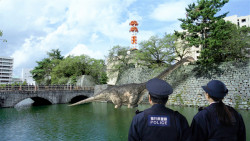
Originally published on metropolis.co.jp on October 2012

The impression given by the prints, paintings, and drawings of the Belgian artist James Ensor (1860-1949) is of an eccentric, bordering on tortured insanity. The reality, however, is that he was a much respected pillar of the establishment, made a Baron of Belgium in 1929. The latest exhibition at the Sompo Japan Museum, “James Ensor in Context,” tries to explain this paradox.
The show starts with the artist’s more conventional works, such as the post-Impressionistic The Oyster Eater (1882), a large, luminous work showing the Victorian obsession with cluttering detail and cloying colors, and the self-conscious Self-portrait at the Easel (c. 1890). These are set in the context of the general tradition of Flemish art, with examples by earlier artists. The exhibition then proceeds through increasingly odd works to the ghoulish caricatures for which he is most remembered, and which influenced the later Surrealist movement.
This is a difficult exhibition for visitors to “read” for two reasons. First, the idiosyncratic nature of the main artist. Second, the patchiness of the accompanying works. These include a small Rubens, a Gustave Courbet landscape, a portrait by Jacob Jordaens, works by one of the lesser known members of the famous Brueghel family, and a selection of works by Ensor’s contemporaries. Through its confusion, the exhibition’s message seems to be that Ensor, despite the note of insanity in many works, was operating within the grand artistic traditions of Europe, and that even his strangest works hark back to the Old Masters.
One of Ensor’s most disturbing works is The Man of Sorrows (1891), a pseudo-naïve caricature of Christ bleeding profusely. Painted by an unknown, this twisted cartoon-like work might be dismissed as the product of a mental patient. But the show includes a 16th-century Dutch work illustrating the relish with which Ensor’s forebears also painted the wounded messiah.
A similar thread of madness runs through David Teniers the Younger’s Temptation of Saint Anthony (undated). This has flying fishes and jousting demons straight out of Hieronymus Bosch.

Connections like this create a consciousness of the insanity or macabre lying beneath European civilization—and occasionally breaking through. This tension is skillfully captured by one of Ensor’s friends, Alfred Stevens, in The Desperate Woman (1875-80). Despite her trappings of wealth and elegance, the subject, still young, stares out at the viewer with a hopeless and haunting stare.
Encountered on their own, works like Ensor’s Skeletons Fighting over a Hanged Man (1891) and The Intrigue (1890) suggest a dark, twisted mind at work. The latter has some of the same creepy atmosphere that Stanley Kubrick captured in Eyes Wide Shut. But in this context, the note of insanity in these works is transformed into a sophisticate’s jaded joke.







